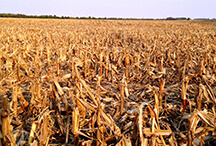Making biofuel from corn crop residue could become economically viable for farmers with government support and, therefore, lead to a major shift in crop rotation practices favoring more continuous corn plantings, Purdue University researchers conclude.

Corn stover, also called stubble, is what remains on an Indiana field after harvest.
The agricultural economists examined how the development of corn stover for cellulosic ethanol would affect corn and soybean markets and the traditional corn-soybean crop rotation in the United States.
Corn stover is considered a “second-generation” biofuel feedstock because it involves transforming the cellulosic material in the stover to biofuels instead of using the corn starch as in conventional corn ethanol.
“If second-generation biofuels became economically viable and a massive amount of biofuels were produced from agricultural residue, this could have a major impact on the agricultural commodity markets,” said energy policy specialist Wallace Tyner, the James and Lois Ackerman Professor of Agricultural Economics and a co-author of the research report.
Also on the team were lead author Farzad Taheripour, a research associate professor, and graduate student Julie Fiegel.
“The development of second-generation biofuels is critically important to advancing the biofuels industry, Taheripour said. “First-generation biofuels, produced from food crops, will not be able to replace a large portion of the oil-based liquid fuels because a rapid expansion in these biofuels could have adverse impacts on our food supply.”
If technology and government support become economically viable, converting corn stover to biofuels would affect the profitability of corn production compared with other crops and also the crop rotation practices in the Midwest, the researchers said. There likely would be more continuous corn versus the traditional corn-and-soybean rotation. Also, corn and soybean production would expand to areas other than the historic Corn Belt.
The researchers concluded that the supply of stover-based bio-gasoline would be very limited at low levels of crude oil prices in particular when the government does not support bio-gasoline production. But with a bio-gasoline subsidy of $1.01 per gallon, the market would produce significant amounts of bio-gasoline, especially at medium and higher crude prices.
The researchers projected that with a viable corn stover market and stover at a farm price of $85.40 a ton, a large majority of farmers would find it profitable to harvest stover.
If converting corn stover to biofuel becomes profitable, either because of market forces or government supports, then farmers would consider revenue from both stover and corn in making planting decisions, the researchers said. If the joint profits from corn and corn stover are higher than from soybean production, the researchers said farmers likely would grow more corn.
Source: purdue.edu